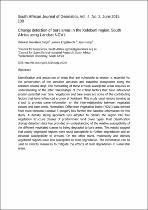 ResearchSpace
ResearchSpace
Change detection of bare areas in the Xolobeni region, South Africa using Landsat NDVI
JavaScript is disabled for your browser. Some features of this site may not work without it.
- ResearchSpace
- →
- Research Publications/Outputs
- →
- Journal Articles
- →
- View Item
| dc.contributor.author |
Singh, RG

|
|
| dc.contributor.author |
Engelbrecht, Jeanine

|
|
| dc.contributor.author |
Kemp, J

|
|
| dc.date.accessioned | 2016-01-20T09:53:46Z | |
| dc.date.available | 2016-01-20T09:53:46Z | |
| dc.date.issued | 2015-06 | |
| dc.identifier.citation | Singh, RG, Engelbrecht, J and Kemp, J. 2015. Change detection of bare areas in the Xolobeni region, South Africa using Landsat NDVI. South African Journal of Geomatics, Vol. 4(2), pp. 213-223 | en_US |
| dc.identifier.issn | 2225-8531 | |
| dc.identifier.uri | http://www.sajg.org.za/index.php/sajg/article/view/257/142 | |
| dc.identifier.uri | http://hdl.handle.net/10204/8364 | |
| dc.description | Copyright: 2015 CONSAS. Due to copyright restrictions, the attached PDF file only contains an abstract of the full text item. For access to the full text item, please consult the publisher's website. The definitive version of the work is published in South African Journal of Geomatics, Vol. 4(2), pp. 213-223 | en_US |
| dc.description.abstract | Identification and protection of areas that are vulnerable to erosion is essential for the conservation of the sensitive wetlands and estuarine ecosystems along the Xolobeni coastal strip. The forecasting of these erosion susceptible areas requires an understanding of the inter-relationships of the critical factors that have influenced erosion potential over time. Vegetation and bare areas are some of the contributing factors that have influenced erosion at Xolobeni. This study used remote sensing as a tool to provide some information on the inter-relationship between vegetated classes and bare areas. Normalised Difference Vegetation Index (NDVI) data derived from multi-temporal Landsat 5 imagery has formed the baseline information for this study. A density slicing approach was adopted to classify the region into four vegetation structure classes of predominant land cover types. Post classification change detection data has provided an understanding of the relative susceptibility of the different vegetated classes to being degraded to bare areas. The results suggest that poorly vegetated regions were most susceptible to further degradation and an elevated susceptibility to erosion. On the other hand, moderately and densely vegetated regions were less susceptible to land degradation. The information can be used to identify measures to mitigate the effects of land degradation in vulnerable areas. | en_US |
| dc.language.iso | en | en_US |
| dc.publisher | CONSAS | en_US |
| dc.relation.ispartofseries | Workflow;15523 | |
| dc.subject | Soil erosion | en_US |
| dc.subject | Change detection | en_US |
| dc.subject | Landsat | en_US |
| dc.subject | Normalised Difference Vegetation Index | en_US |
| dc.subject | NDVI | en_US |
| dc.subject | Xolobeni region | en_US |
| dc.title | Change detection of bare areas in the Xolobeni region, South Africa using Landsat NDVI | en_US |
| dc.type | Article | en_US |
| dc.identifier.apacitation | Singh, R., Engelbrecht, J., & Kemp, J. (2015). Change detection of bare areas in the Xolobeni region, South Africa using Landsat NDVI. http://hdl.handle.net/10204/8364 | en_ZA |
| dc.identifier.chicagocitation | Singh, RG, Jeanine Engelbrecht, and J Kemp "Change detection of bare areas in the Xolobeni region, South Africa using Landsat NDVI." (2015) http://hdl.handle.net/10204/8364 | en_ZA |
| dc.identifier.vancouvercitation | Singh R, Engelbrecht J, Kemp J. Change detection of bare areas in the Xolobeni region, South Africa using Landsat NDVI. 2015; http://hdl.handle.net/10204/8364. | en_ZA |
| dc.identifier.ris | TY - Article AU - Singh, RG AU - Engelbrecht, Jeanine AU - Kemp, J AB - Identification and protection of areas that are vulnerable to erosion is essential for the conservation of the sensitive wetlands and estuarine ecosystems along the Xolobeni coastal strip. The forecasting of these erosion susceptible areas requires an understanding of the inter-relationships of the critical factors that have influenced erosion potential over time. Vegetation and bare areas are some of the contributing factors that have influenced erosion at Xolobeni. This study used remote sensing as a tool to provide some information on the inter-relationship between vegetated classes and bare areas. Normalised Difference Vegetation Index (NDVI) data derived from multi-temporal Landsat 5 imagery has formed the baseline information for this study. A density slicing approach was adopted to classify the region into four vegetation structure classes of predominant land cover types. Post classification change detection data has provided an understanding of the relative susceptibility of the different vegetated classes to being degraded to bare areas. The results suggest that poorly vegetated regions were most susceptible to further degradation and an elevated susceptibility to erosion. On the other hand, moderately and densely vegetated regions were less susceptible to land degradation. The information can be used to identify measures to mitigate the effects of land degradation in vulnerable areas. DA - 2015-06 DB - ResearchSpace DP - CSIR KW - Soil erosion KW - Change detection KW - Landsat KW - Normalised Difference Vegetation Index KW - NDVI KW - Xolobeni region LK - https://researchspace.csir.co.za PY - 2015 SM - 2225-8531 T1 - Change detection of bare areas in the Xolobeni region, South Africa using Landsat NDVI TI - Change detection of bare areas in the Xolobeni region, South Africa using Landsat NDVI UR - http://hdl.handle.net/10204/8364 ER - | en_ZA |





